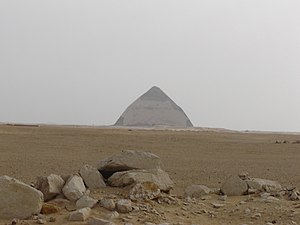Saqqara is the name given both to a village 32 km to the south of the Egyptian capital of Cairo and (more particularly) to the extensive ancient necropolis on the plateau above the Nile Valley, the location of tombs and pyramids dating to the Predynastic, Old Kingdom, New Kingdom and Late Periods of ancient Egyptian history.
Understand

The desert plateau above the modern village of Saqqara formed one of the main cemeteries of the ancient Egyptian capital city of Memphis for thousands of years. As such, it attracted a large number of royal and high prestige burials, the remains of which can be seen in pyramids and decorated tombs scattered across the area. The site of Saqqara is quite extensive, stretching 6 km north-south and 1.5 km across at its widest point.
Get in
By taxi / cab
Taxis can be hired from central Cairo to visit Saqqara. Negotiate with your driver for a daily rate.
By bus
Travelers may be told there is no bus to Saqqara. This is not entirely true.
Bus services do exist to Saqqara from central Cairo, but entail a lengthy journey and a long walk from the village up to the plateau.
Alternatively, it is possible to reach the plateau by taking a microbus from the Giza metro station. It should be expected to transfer to multiple microbuses as there is no direct microbus. Tell the driver you want to go to "Marishay" and then Saqqara" and he should indicate where to transfer. Prices vary based on where the transfer points are from 25 piasters to 3 pounds. Once in Saqqara village, take a tuk-tuk for a few pounds to the site.
Get around
See
Saqqara
- Saqqara Necropolis. open daily 8am-5pm. admission LE£60/ student LE30.
- Step Pyramid of Djoser. This structure marks the transition between the bench-like mastaba style of burial and the true pyramid shape (first seen at Dahshur).
- Pyramid of Teti I and Teti Period Cemetery. The pyramid tomb of the first ruler of the 6th Dynasty, the Pyramid of Teti was quickly surrounded by the tombs of his nobles and officials upon its completion.
- Tomb of Mereruka.
- Tomb of Kagemni.
- Tomb of Ankhmahor.
- Serapeum.
- Mastaba of Ti. A 'classic' Old Kingdom tomb of a high noble and one of the richest sources of information about life during that period, the mastaba tomb of Ti is one of the grandest and best-decorated examples of funerary architecture in Egypt.
- Unas Causeway. Leading to the Pyramid of Unas
- Imhotep Museum, ☏ +2 (02) 3818-3095. open daily 8am-4pm..
Dahshur

Inscribed on the UNESCO World Heritage List, Dahshur formed part of the extensive necropolis of ancient Memphis during the Old Kingdom - the so-called "Pyramid Age". The pharaoh Sneferu (sometimes spelt Snofru), founder of the 4th Dynasty and the father to Khufu - builder of the Great Pyramid at Giza) - managed to erect two complete pyramids at the location, in addition to completing another pyramid (for his predeccesor Huni) at Meidum. In sheer volume alone, the father definitely out-did his son!
Somewhat later, pharaohs of the Middle Kingdom's 12th Dynasty erected their own pyramids at the locality - though on a greatly reduced scale.
Dahshur is very much off the traditional tourist trail around Cairo, having been a restricted military zone until 1996. The Egyptian Supreme Council of Antiquities has in recent years, however, been encouraging travellers to visit Dashur, in an attempt to relieve some of the pressure on the Giza pyramids.
The Dahshur Necropolis is open daily 8am-5pm, admission LE£20. The pyramid field extends over 3.5 km north to south.
- the Bent Pyramid of Sneferu - very aptly named, on account of its sudden, startling change in angle halfway up the pyramid, from the steep 54 degrees at the base, to a far more gentle 43 degrees.
- the Red Pyramid of Sneferu (also known as the North Pyramid) - Egypt's oldest true pyramid (without steps, without bends), probably on account of the red hues of its weathered limestone, now exposed to the elements after the original hard white limestone casing was removed (probably in late antiquity or the medieval period). Some say, however, that the 'red' designation may stem from red graffiti and building marks found around the structure. Well preserved, the Red Pyramid was probably built after the Bent Pyramid, the architects apparently learning from the alterations necessary in the earlier structure, and incorporating the same gentle 43 degree angle used in the upper portion of the Bent Pyramid to construct the Red Pyramid in its entirety. The interior of the Red Pyramid is accessible to the public, after scaling 125 steps. A long, slanting corridor (63 m) leads visitors down to three interior chambers: two antechambers with 12 m high corbelled vaults and a 15 m high burial chamber with a corbelled ceiling. Human remains, perhaps those of Sneferu himself, were found in this location.
- the Black Pyramid of Amenemhat III
Do
Buy
Eat
Drink
Sleep
Go next
